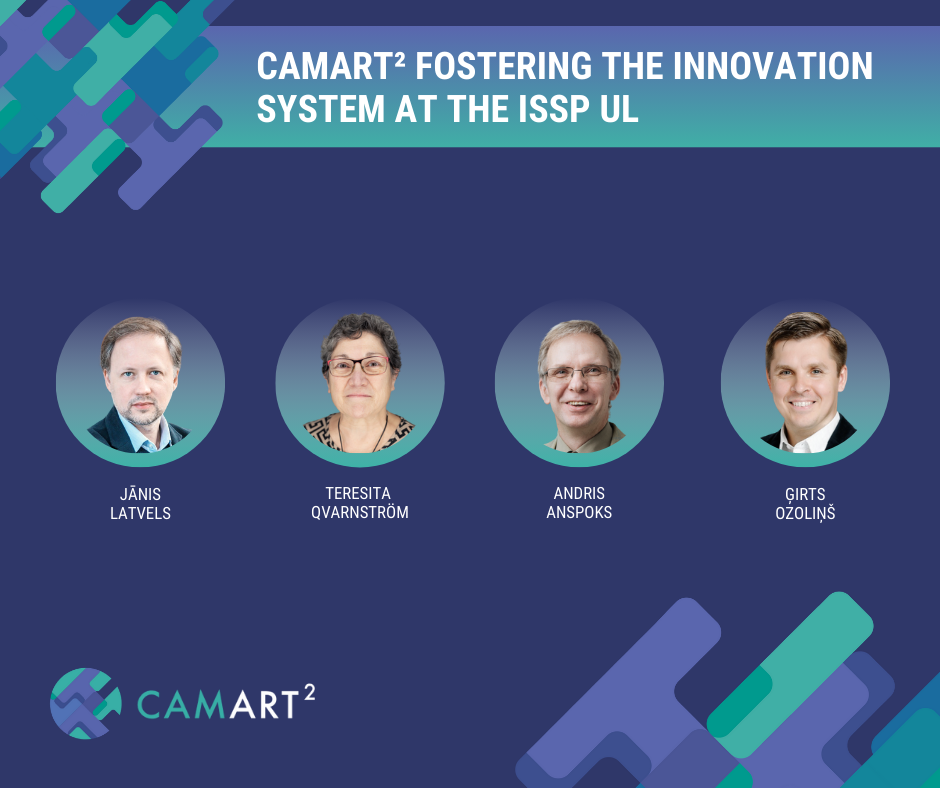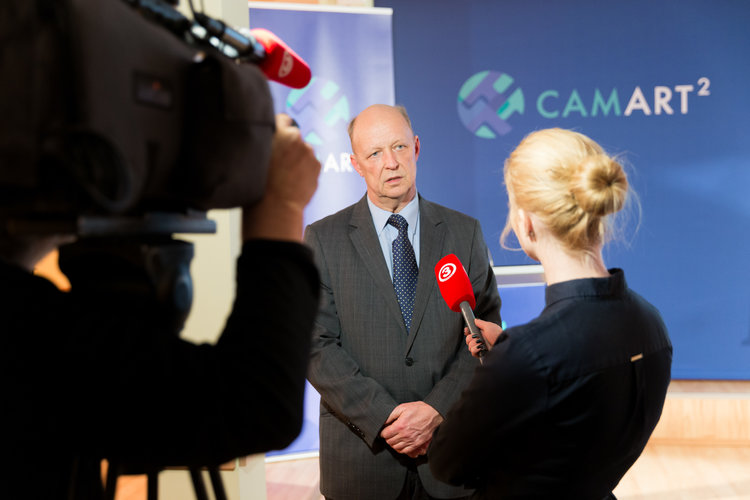This is the fourth article in the CAMART2 series about the impact of this 8-year project on the Institute of Solid State Physics, University of Latvia (ISSP UL). This time, we talked to Dr. Teresita Qvarnström, project leader and business developer at RISE, Dr.phys. Andris Anspoks, the director of the ISSP UL, Dr.sc.ing. Jānis Latvels, who has worked to introduce the innovation system at the ISSP UL and has organized the first hackathons in Deep Science in Latvia, and Ģirts Ozoliņš – a senior expert in promoting ISSP UL’s innovations. They shared insights on how a structured system for developing innovations at ISSP UL was established and how the project consortium partners—RISE (previously Acreo) and the KTH Royal Institute of Technology (KTH)—contributed to creating a system for working with innovations.
Before the CAMART2 project, ISSP UL’s approach to innovation was stochastic and lacked a systematic process. Partnering with Acreo (later part of RISE) and KTH as key partners in CAMART2 emphasized the need for a structured system to ensure successful commercialization. Acreo’s experience in technology transfer and spin-off creation was instrumental in shaping ISSP UL’s innovation strategy. The collaboration with Acreo and later RISE, which implements government strategies on innovation and technology, highlighted the importance of utilizing scientific findings to develop societal solutions. Sharing knowledge and experiences with RISE helped ISSP UL tailor its approach to local needs and conditions, fostering a competitive and evolving organization.
Collaborative efforts lead to building a systemic approach
CAMART2 helped structure internal processes, providing a general framework for innovation management. Collaboration with RISE and KTH allowed ISSP UL to learn from their successes and also failures, tailoring these lessons to fit Latvian conditions. This partnership fostered one of the most significant achievements: a cultural change within ISSP UL, encouraging researchers to view technology transfer as a viable path, similar to research projects. RISE and KTH, with their experience, were crucial in developing our innovation system from scratch.
CAMART2 also facilitated international relations and travel, allowing the ISSP UL team to learn from various examples and integrate suitable methodologies into the organization. Implementing the CAMART2 project emphasized the need for a tailored approach to intellectual property management and the importance of protecting and commercializing research results. Hackathons played a crucial role in generating ideas and fostering innovation. It is worth mentioning that the ISSP UL was the first to introduce a Deep Science hackathon culture in Latvia.
Among other recent project activities aimed at furthering the innovation system at the ISSP UL, foresight and AI workshops are noteworthy, as they broadened perspectives and knowledge on innovation management.
Innovation system development at the ISSP UL
One key task defined from the beginning of CAMART2 was developing the innovation system, and another involved collaborating with Latvia’s national program on commercializing research results. This period was marked by significant learning and development, as ISSP UL had no existing technology transfer and innovation system in place.
Developing internal processes at ISSP UL to establish a stable, open system for industry-relevant research was a broad and important task. Materize played a key role in this cultural change, engaging everyone at the institute. Nationally, ISSP UL became a significant partner in innovation and technology transfer, contributing to national development.
Cultural change was key, involving awareness-raising and seminars. KTH’s methodology for assessing innovation readiness levels was used in various projects. Intellectual property management was another focus, with partners and local authorities playing roles. The Investment and Development Agency of Latvia (LIAA) program for commercializing research results was a key driver, attracting 1.5 million euros to ISSP UL and resulting in successful commercialization.
Success stories and impact
The success stories demonstrate the impact of the systemic approach to innovation at ISSP UL. Hackathons played a crucial role in generating ideas and fostering innovation. A total of ten events have taken place during the CAMART2 project, including the Deep Science and Student Deep Science Hackathons, as well as the Future Medicine Hackathon, which focused on future medicine technologies in space, and the Hydrogen X Future Hackathon, which concerned hydrogen and future energy materials.
Several ideas from these hackathons led to technology transfer and international projects. Notable success stories include the organ-on-a-chip technology in the microfluidics field, which has evolved into ISSP UL spin-off Cellbox Labs, winner of the Latvia Best Startup Award 2023. Another notable success is the robotic skin idea, first conceived at the very first Deep Science hackathon and later developed into the Horizon Europe project Sestosenso. An Optoskin prototype developed by the Sestosenso consortium was recognized by the European Commission’s Innovation Radar initiative in 2024.
CAMART2 also highlighted the importance of managing intellectual property (IP) and successfully commercializing technologies. Deep tech projects often take years to reach the market. For example, the High-Speed Thermoelectric Radiation Sensor (TESS) project, a thermoelectric sensor, took 10 years from idea to success – the sensor’s license was acquired by Thorlabs, the world’s leading manufacturer of innovative optical instruments.
Patenting is crucial for protecting intellectual property (IP), and ISSP UL has developed a system to evaluate market potential and competition, prepare tailored documentation, and inform decisions on patenting strategies. Projects like the Optical gas sensor for ammonia detection and the Spectromarine water quality monitor have patents, and those technologies are still undergoing development. The methodology ISSP UL applied has led to significant advancements in various fields, including biotech and space communication.
Not all projects succeed, but understanding industry benchmarks is crucial. This approach helps us focus on viable innovations.
Lessons learned and future directions
The ISSP UL is grateful to our partners, RISE and KTH, whose experience has been invaluable. Learning from them has accelerated the ISSP UL progress. For example, with organ-on-chips (Cellbox Labs), ISSP UL received excellent advice from Caroline Dahl (RISE), and KTH Innovation guided us in finding and assessing ideas. Having dedicated people working on specific ideas has been crucial and will continue to be important in the future. The collaboration with the government and support from LIAA, along with the establishment of the Innovation Fund - Long-Term Research Program, by the Ministry of Economics of Latvia, has been instrumental.
The ISSP UL has established a strong teamwork culture, sharing wild thoughts, successes, mistakes, strengths, and weaknesses in a safe environment. This collaboration fostered a creative culture in CAMART2. In Sweden and Europe, ISSP UL has gained recognition, and many want to connect and collaborate, bringing pride to RISE and KTH. ISSP UL boasts a skilled staff capable of delivering innovative results. The ISSP UL’s reputation as innovation champions is well-deserved. Many institutions now look to ISSP UL as a model, with big universities establishing innovation departments similar to our Materize platform.
This impact extends to the photonics, smart materials, technologies, and engineering ecosystem, fostering open meetings and discussions among national research institutions and industry representatives. This collaborative environment is crucial.
Creativity is essential. While researchers are inherently creative, true cultural change begins with open collaboration on ideas. Openness and communication are the institute’s strengths. Unlike many institutions where projects are developed in isolation, ISSP UL fosters collaboration, believing that collective efforts yield better results. Creativity drives both innovation and research, with bold ideas leading to significant achievements.
For ISSP UL, CAMART2 was a cultural revolution with a substantial impact. Internally, the ISSP UL continues to grow, and its progress is recognized externally, maintaining its reputation as an innovation leader in Latvia. The ISSP UL aims to sustain this reputation while fostering collaboration and interdisciplinary work. We believe that the CAMART2 project is just the beginning.
Materize – launched in 2018, it was created with a clear vision: to facilitate and enhance collaboration between scientific research and industry. This platform serves as a vital link, addressing the communication gap between scientists and entrepreneurs and positioning itself as a “one-stop-shop” for tailored industrial services.
LIAA works to increase export and competitiveness of Latvian companies, facilitate foreign investment and implement tourism development and innovation policies.
Cellbox Labs – ISSP UL spin-off company developing vascularized organ on a chip platform for more precise drug discovery. The combination of hardware and software allows for flexible experiment design and significantly reduces hands-on time.
Sestosenso – a Horizon Europe project towards safer and more efficient robotics, which the ISSP UL implements together with the consortium partners from Europe. The project is pioneering a new sensor technology designed to create an innovative skin for robots. This advancement aims to improve robots’ perception of their environment and facilitate seamless cooperation with human workers, ultimately enhancing workplace safety and productivity.
Optoskin - a state-of-the-art touch sensor that mimics the functionality of human skin. The potential applications of this technology are vast. By integrating Optoskin into robots, factories could see a dramatic reduction in the time and costs associated with reprogramming robots for different tasks.
Optical gas sensor - can identify different gases and detect their concentration in air. Main advantage of this technology would be high sensitivity, fast response time, robustness and simple fabrication.
Spectromarine – fully autonomous optical water quality sensor developed by a team of scientists to match industry needs.
Innovation Fund - Long-Term Research Program aims to support early-stage applied science and commercial research in biomedicine and photonics/smart materials through collaboration between research and industry, with phased funding totaling up to 24 million euros.
Photonics, smart materials, technologies, and engineering ecosystem - focuses on interdisciplinary research. It brings together Latvian scientists to develop industry-relevant technologies through collaborative efforts.
FURTHER READING
Read more about the foresight workshop organized by RISE at the ISSP UL
Read more about AI workshop organized by RISE at the ISSP UL
Read more about Cellbox Labs winning the Latvia Best Startup Award in 2023



